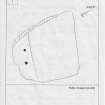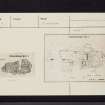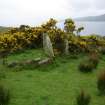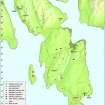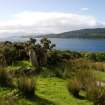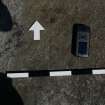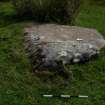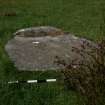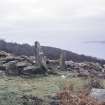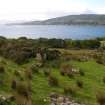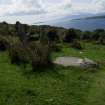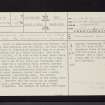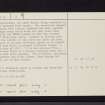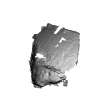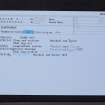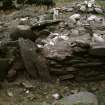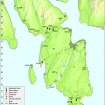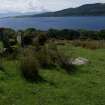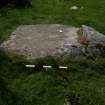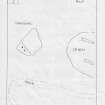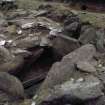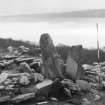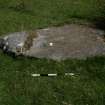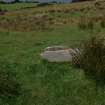Pricing Change
New pricing for orders of material from this site will come into place shortly. Charges for supply of digital images, digitisation on demand, prints and licensing will be altered.
Upcoming Maintenance
Please be advised that this website will undergo scheduled maintenance on the following dates:
Thursday, 9 January: 11:00 AM - 3:00 PM
Thursday, 23 January: 11:00 AM - 3:00 PM
Thursday, 30 January: 11:00 AM - 3:00 PM
During these times, some functionality such as image purchasing may be temporarily unavailable. We apologise for any inconvenience this may cause.
Bute, Glenvoidean 2
Chambered Cairn (Neolithic), Corn Drying Kiln (Medieval), Cup Marked Stone (Neolithic), Short Cist (Bronze Age), Food Vessel (Pottery)(Bronze Age)
Site Name Bute, Glenvoidean 2
Classification Chambered Cairn (Neolithic), Corn Drying Kiln (Medieval), Cup Marked Stone (Neolithic), Short Cist (Bronze Age), Food Vessel (Pottery)(Bronze Age)
Canmore ID 39897
Site Number NR97SE 2
NGR NR 99711 70572
Datum OSGB36 - NGR
Permalink http://canmore.org.uk/site/39897
- Council Argyll And Bute
- Parish North Bute
- Former Region Strathclyde
- Former District Argyll And Bute
- Former County Buteshire
NR97SE 2 99708 70570.
NR 997 705. Prior to excavations carried out between 1963 and 1971 by Miss Marshall and Mrs Taylor, the much ruined chambered cairn at Glenvoidean appeared only as a grass-covered platform set on a steep hillside. The cairn measures 42ft N-S, 22ft wide at the N end, where there is a flattish facade, narrowing to 16ft at the S end. The E side and S end of the cairn are relatively well-preserved, edged by a wall-face still several courses high in places; the downhill (S) side is too ruined to trace accurately. The excavations revealed a two compartment axial chamber, behind which was a small, probably medieval, corn-drying kiln. Two lateral chambers, entered from opposite sides of the cairn, were also found. Inserted into the cairn was an unusual Bronze Age cist, divided into two tiers by a large horizontal flagstone. The remains of burials were found in both compartments, the upper burial being contained in an inverted enlarged food vessel. The excavators suggest that originally both lateral chambers had been together under a single round cairn which had only later been joined up with the front chamber to form the present trapezoidal Clyde-type cairn. Patches of burning were seen round the outside of the cairn and under the kerb, which is built in so many different styles as to suggest that it had been built in several different stages. A radiocarbon date of 2910 +/- 115 bc was obtained from a sample of carbon found in a primary position under the W slab of the main axial chamber. The artifacts, including neolithic pottery and flint flakes, found during the excavations, are in Bute Museum.
Current Archaeology 1972; A S Henshall 1972; D N Marshall 1969.
Excavation (1963 - 1971)
Reference (1972)
Field Visit (21 October 1976)
NR 9971 7057 A chambered cairn as planned and described in the previous information.
Surveyed at 1:10 000.
Visited by OS (B S) 21 October 1976.
Reference (1978)
Field Visit (19 May 2009)
This chambered long cairn, which has been built on a platform or terrace on a steep SW-facing slope 400m SE of Kilmichael farmsteading, was largely obscured by dense gorse on the date of visit. Features that were visible included the axial burial-chamber, a portal stone and part of the facade at the N end, two lateral burial-chambers, one entered from the W side of the mound, the other from the E, and trenches and spoil-heaps from excavations. Neither the bronze age cist nor the medieval corn drying kiln were identified. Two cup marks, both measuring at least 50mm in diameter and 10mm in depth, are visible on one of the former roofing slabs of the axial burial-chamber, which now lies 4m to the NW of the chamber.
Visited by RCAHMS (GFG, PM) 19 May 2009.
Note (2 April 2018)
Date Fieldwork Started: 02/04/2018
Compiled by: Rock Art Bute
Location Notes: This panel is a former capstone from the axial burial chamber of the Glenvoidean chambered cairn, and now lies about 4m to the NW of the chamber. It is located in rough grazing on a SW sloping hillside with open views to Arran, Inchmarnock, and Ardmalont Peninsular
Panel Notes: This large, roughly square schist slab measures 1.91x1.62m. There are 2 cupmarks on the W end of the panel which is slightly raised and has a rougher surface than the rest of the slab. The smooth, flat, lower surface on the eastern portion of the slab suggests that its original surface may have been sheared off.
































